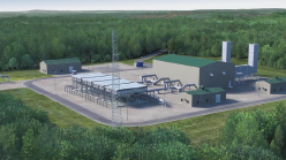The natural gas industry in the United States is undergoing major changes that are reshaping traditional roles, creating opportunities for new participants, and redefining the scope and character of government regulation. As the result of proposals at both the state and federal level to further "unbundle’ retail gas sales and create more robust secondary markets for pipeline capacity, the interstate natural gas pipeline industry may be buffeted by another round of regulatory changes.
Study Findings
Fragmenting Customer Base
The traditional customer base of transmission pipelines is fragmenting and will continue to fragment in the near future. This fragmentation will provide significant opportunities for new entities organized around the central functions of competitive markets: marketing and customer service. To be successfil, pipelines will have to gain access to a complete set of competencies through a combination of internal development and strategic alliances that establish market presence from the wellhead to the burnertip.
Customer Concerns
As the pipeline industry has evolved since the early 1980s, its customer profile has changed significantly. Understanding customer opportunities and needs is critical to developing the ability to provide the type of tailored product and service offerings customers reported they want from their pipeline companies.
The Current Market – Two Arenas for Determining Value
The value of pipeline capacity now is determined in two separate arenas:
- the difference in the market value for natural gas in separate locations (basis differentials)
- the secondary market for interstate capacity.
The Future Price of Capacity
As the markets for firm capacity develop more Illy, the open market price of capacity on specific pipeline segments will drive customers’ actual transport costs, and therefore both burnertip prices and producer netbacks.
- The upper end of prices will be limited by the availability and cost of alternative pipeline routes, and by alternatives to firm transportation such as storage, liquefied natural gas,alternative Iels, and demand-side management. .
- The minimum value will fluctuate around the marginal I e l costs.
Original pipeline costs, currently the basis for pipeline ratemaking, are likely to play little or no role in determining the market-driven value in the future.
Pipeline Construction
Low market prices for capacity and high demand charges are also driving changes in the economics of new facilities construction. This results in:
- a much more difficult market for financing new pipeline construction
- a much more market-oriented environment for new pipeline construction.
Increased sophistication in the capacity markets will isolate higher value pipeline segments and will attract construction designed to relieve specific bottlenecks rather than to create new longhaul capacity. Investors are likely to be only those who need the capacity for more strategic purposes – producers and capacity merchants – where the overall project is profitable, even if the pipeline piece is not. Current expansion into the Midwest from Canada and the U.S. Rockies is an example of this phenomenon – producers are the major underwriters of these projects in efforts to find new premium markets for their gas. Under this growing uncertainty, long-term firm upstream contracts are beginning to look more like liabilities than assets for those companies holding the capacity. If fill LDC unbundling occurs before contract terms end, firm capacity may become a stranded cost.
Constraints to a Mature Capacity Market
As the secondary markets mature, transmission capacity in major supply corridors will become increasingly like a commodity, with basis differentials and pipeline capacity values converging. However, three major developments in the industry will have to occur to increase the liquidity and trading effectiveness of this marketplace:
- relaxation of capacity release restrictions by the Federal Energy Regulatory Commission
- improved flexibility through hubs and market centers
- more compatible and comprehensive information and trading systems.
The competitiveness of specific markets will be both driven and limited by market liquidity, with capacity in major transport comdors freely traded and reliably priced, and with values in less traveled comdors experiencing more volatility and price differentiation.
With a more liquid and effective secondary market for capacity, the most valuable and least valuable segments of capacity will become more isolated. In many cases, the most valuable segments are around very specific bottlenecks. With the growing financial risk associated with holding long-haul pipeline capacity, many new construction projects are now focusing on relieving these specific bottlenecks. Where bottlenecks are only seasonal in nature, pipeline construction will compete with storage, he1 substitution, or other forms of peak period demand management.
Capacity Transformation
Transmission capacity, or the right to transport natural gas on the nation’s pipeline grid, is going the way of natural gas itself – it is being rapidly transformed into a traded commodity. Pipeline operations, investment, and financing will see hndamental changes as capacity transforms from its traditional status as a regulated fixed asset to a traded commodity. The pipeline business will look more and more like other capital intensive businesses that experience volatile price changes for their products.
Although the provision of firm transportation service can be expected to remain the backbone of the interstate pipeline’s business, it may be the ability of pipelines to complement this service with diverse, flexible, and cost-reducing service alternatives that will determine both their share of the value-added market and how much firm capacity they are able to sell.
Outlook
The significance to the pipeline industry of a world in which the value of pipeline capacity is driven by changes in the commodity’s value fiom one location to the next, rather than the embedded cost of transport, is difficult to overestimate. The changes in pipeline valuation will alter who controls and pays for new pipeline capacity, the types of projects that are built, producer netbacks, and customer prices. These changes will affect the core business of the pipeline companies themselves most directly. These changes are likely to include:
- commodity trading in pipeline capacity
- a shift to shorter-term contracts
- growing risk exposure for pipeline companies
- new opportunities to provide services for increasingly sophisticated customers
- a difficult market for new major pipeline construction projects
- clearer price signals
- shifts in pipeline ownership.
The good news is that new opportunities are associated with this increased risk, especially for companies that can respond effectively to new needs of customers.





